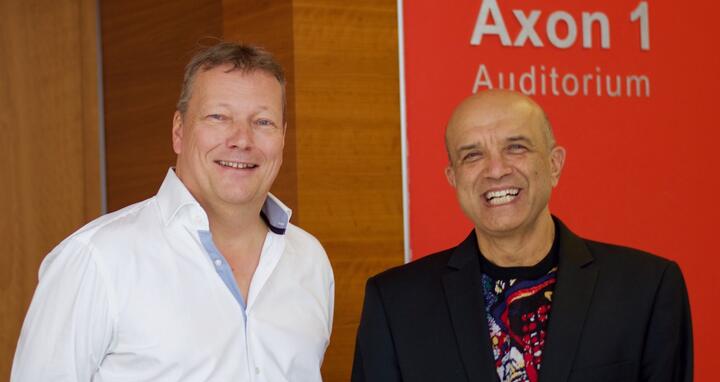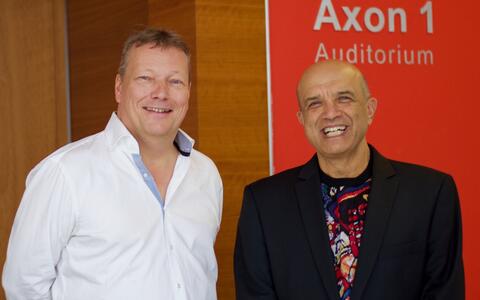MDC Lecture: Vishva Dixit on cell death and combating sepsis
According to Dr. Vishva Dixit, biomedical research is progressing much faster than the textbooks can keep up with. The researcher is vice president of the San Francisco-based firm Genentech – the second largest biotechnology company in the world. As the guest speaker for the MDC Lecture on September 20, he spoke before a full auditorium about his research into programmed cell death and the opportunities this presents for the treatment of sepsis.
Who better to provide a comprehensive overview of the topic of cell death than Vishva Dixit? At the invitation of Prof. Thomas Sommer, MDC’s deputy scientific director, the prominent scientist delivered an MDC Lecture titled “Why So Many Ways to Die? The Non-Canonical Inflammasome Pathway,” which dealt with a central phenomenon of life – death or, more precisely, programmed cell death.
A fascination with death
Dixit is the son of an Indian doctor and grew up in Kenya. His fascination with death started at an early age, as he revealed in an interview with the scientific journal Nature. He trained in Nairobi as a pathologist before turning to basic research in 1980 with the hope of achieving a greater impact with his work. In 1986 he left Washington State University and set up his own laboratory at the University of Michigan Medical School. It was here, in the early 1990s, that he threw himself into the topic of programmed cell death (apoptosis), which was a largely underresearched area at the time.
Since then, Dixit has made a series of breakthroughs in the field and has developed a detailed explanation of the cascade of cellular signals that lead to apoptosis. His work – including that on toll-like receptors that detect parts of bacteria, on the inflammasome that amplifies and transmits these signals inside the cell, and on caspase proteins that activate an irreversible process resulting in cell death – constitutes fundamental research in this area and has tens of thousands of citations.
Dixit has served as vice president of the biotech company Genentech since 1997. Though Dixit no longer works in academia, he still dedicates his time to fundamental scientific questions with a view to combating that phenomenon that interests him the most – death.
Apoptosis – programmed cell death
The targeted destruction of cells is, among other things, one of the body’s ways of fighting infection. In the context of septic shock, however, this process can be life threatening. Every year, six million people around the globe die from this condition. And yet pharmaceutical research into sepsis has hit a brick wall. Dixit explained that after more than 60 failed clinical studies and billions of dollars spent, barely any progress has been made.
One reason for this is that many of the basic principles are still unknown and that new actors are constantly being discovered that play a role in this “dance of death” performed by cellular proteins. “Many things seem obvious in hindsight, but back then we had thousands of candidates,” said Dixit, talking about a recent research project in which he uncovered a previously unknown “non-canonical inflammasome pathway” that activates the lethal molecule caspase-11.
This molecule is activated when parts of the bacterial envelope enter the cell’s interior. This means the cell can die in more ways than one, which poses a major problem for pharmaceutical research. What’s more, important actors in this “signaling cascade” are still unknown – such as the molecular “sensor” that binds the bacterial components.
During his lecture, Dixit recalled how MDC researcher Prof. Klaus Rajewsky once said jokingly to him: “As soon as you find the sensor, I’ll invite you to MDC.” He apologized that he was now standing here without having yet found this enigmatic molecule, but the scientists who filled the auditorium were more than willing to forgive him.
Further information
- Vishva Dixit’s profile page at Genentech
- Mohamed Lamkanfi & Vishva M. Dixit (2017): “In Retrospect: The inflammosome turns 15” Nature
Similar lecture at the Walter and Eliza Hall Institute. Dixit V (2015): Lessons from death – the inflammasome and beyond






